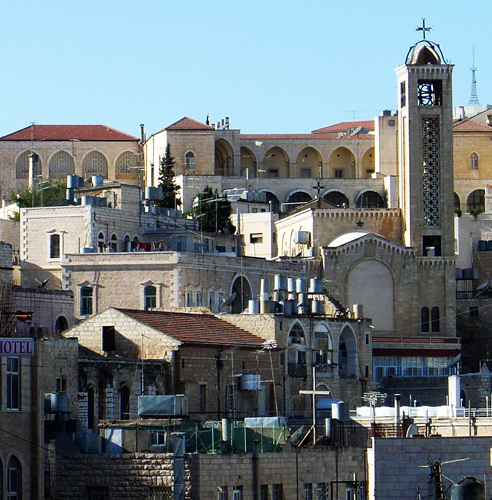Bethlehem is located in the West Bank, about 6 miles south of Jerusalem in the Judean Mountains. It’s home to one of the largest Arab Christian communities, now about 40% of the population, but once around 85%. It’s a small city of about 25,000, with tourism as the main industry.
Besides being the traditional birthplace of Jesus, Bethlehem is the birthplace of King David and the site of the tomb of Rachel. Rachel’s tomb, on the edge of town, attracts Jewish and Muslim pilgrims, but Bethlehem’s star attraction, by far, is the Church of Nativity in Manger Square, in the center of town.

The Church of the Nativity, Bethlehem
The original church was built upon orders from the Roman Emperor Constantine’s mother Helena around the year 327. The emperor Justinian rebuilt the church a couple hundred years later, and that church still stands, the oldest church still in use in the Holy Land. Beneath the church is a cave believed to be the actual spot where Mary gave birth to Jesus. The earliest written accounts of Jesus being born in a cave date from the 2nd century, but the oral tradition is likely much older. Many houses in the area are built up against caves, which were used for storage and animal shelter.

The very spot upon which Jesus was born, according to tradition. This is in a cave under the Church of Nativity in Bethlehem.
Was Jesus really born in Bethlehem? Most scholars think not. Two of the four Gospels, Matthew and Luke, place the nativity in Bethlehem, although the details differ. The other two Gospels, Mark and John, don’t address Jesus’ birth at all. According to Jewish tradition, the Messiah would be descended from King David, and David was born and raised in Bethlehem. Accordingly, the prophet Micah foretold that the Messiah would be born in Bethlehem. It could be that the writers of Matthew and Luke symbolically placed Jesus’ birth in Bethlehem in reference to that prophecy. Journalistic accuracy was not intended or expected.
Personally, I don’t think it matters where exactly Jesus was born, but I do find it interesting to think about the context in which the Gospels were written and their intended audiences. Although they carry an eternal message, the form that message takes tells us a lot about the world of the first Christians. Matthew cites the genealogy of Jesus back through David and ultimately to Abraham. That would have been meaningful to a Jewish audience. Luke’s genealogy goes right back to Adam to encompass all of humanity and he exults the newborn Jesus as savior of the whole world, not only of the Jews. Luke was writing for a Greek, gentile audience.
Getting to Bethlehem is easy, just a short drive from Jerusalem. Tourists pass through an Israeli check-point from Israel to the West Bank Palestinian Territories. Israelis are not allowed to enter, so if you’re on a guided tour, a Palestinian guide will meet you on the other side.
Christmas Eve Midnight Mass is held on December 24-25 at the Roman Catholic St. Catherine’s, next door to the Church of Nativity. Tickets (no charge) are required to attend the service. Christmas is celebrated in Bethlehem on January 6-7 for the Greek, Coptic and Syrian Orthodox Churches and on January 18-19 for the Armenian Orthodox Church.

